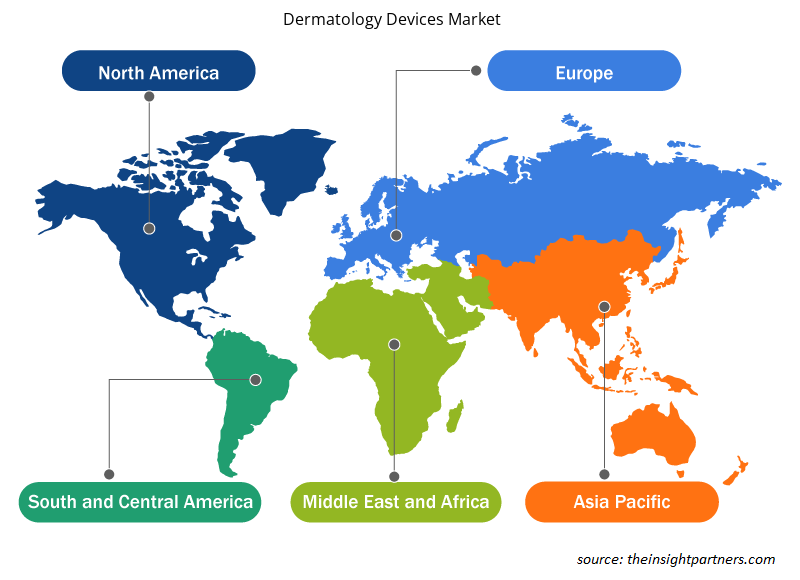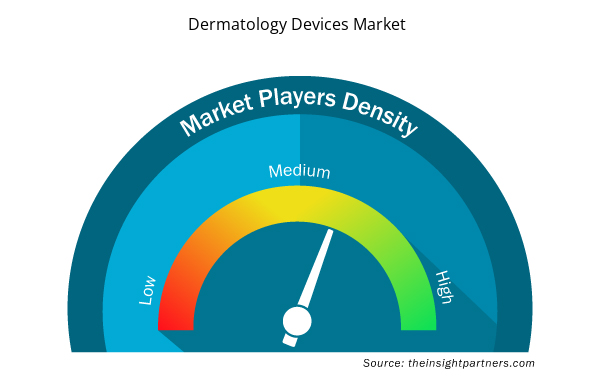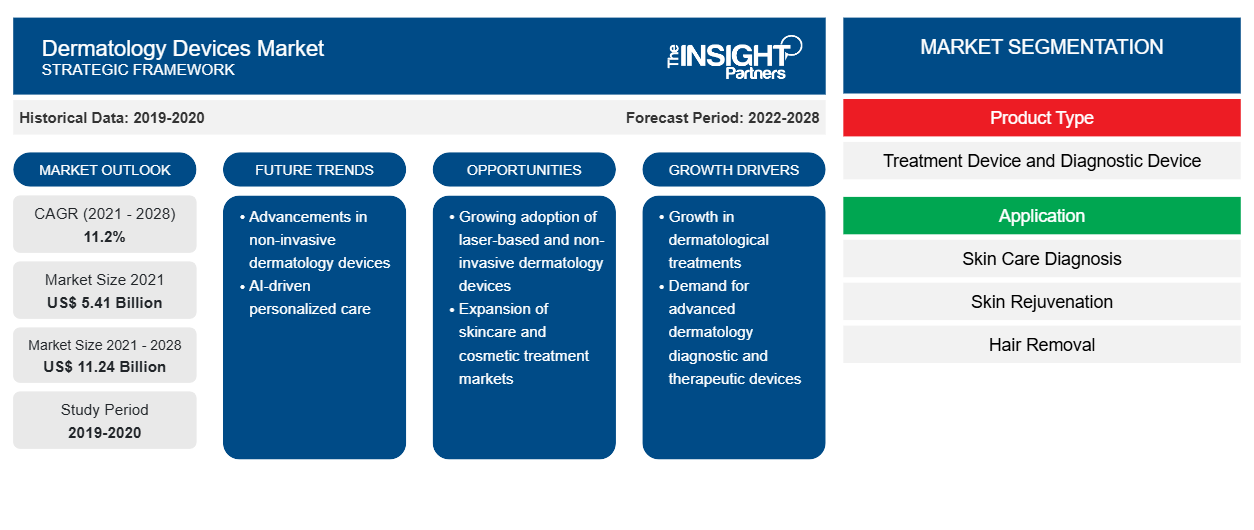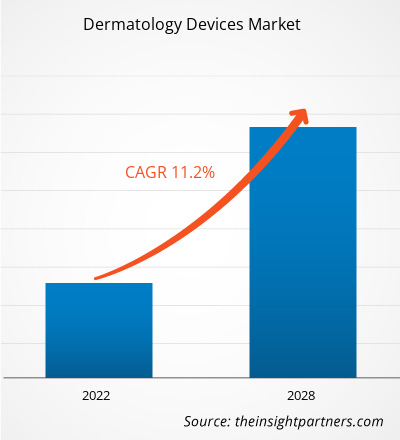بلغت قيمة سوق أجهزة الأمراض الجلدية العالمية 5،408.57 مليون دولار أمريكي في عام 2021؛ ومن المتوقع أن ينمو بمعدل نمو سنوي مركب قدره 11.2٪ من عام 2022 إلى عام 2028.
يسلط التقرير الضوء على الاتجاهات السائدة في سوق أجهزة الأمراض الجلدية والعوامل التي تدفع نموها. يتضمن طب الأمراض الجلدية استخدام مجموعة واسعة من الأجهزة الطبية لإجراء عمليات طب الأمراض الجلدية التجميلية والطبية. تساعد أجهزة الأمراض الجلدية في تشخيص وعلاج العديد من اضطرابات الجلد، مثل سرطان الجلد والصدفية. يمكن استخدامها أيضًا في الجراحة بالتبريد والعلاج الضوئي الديناميكي وجراحة موهس المجهرية والتجفيف الكهربائي والكحت. تلعب إدارة الغذاء والدواء (FDA) دورًا حاسمًا في تنظيم هذه الأجهزة والموافقة عليها ومراقبتها بعد التسويق، مما يضمن سلامتها وفعاليتها.
يقدم التقرير رؤى وتحليلات متعمقة لسوق أجهزة الأمراض الجلدية العالمية، مع التركيز على معايير مختلفة، بما في ذلك اتجاهات السوق والتقدم التكنولوجي وديناميكيات السوق وتحليل المشهد التنافسي للاعبين الرئيسيين في السوق. كما يتضمن تأثير جائحة كوفيد-19 على السوق في جميع المناطق. كان لجائحة كوفيد-19 تأثير مختلط بشكل عام على سوق أجهزة الأمراض الجلدية العالمية. كانت أنظمة الرعاية الصحية مثقلة بالأعباء وسط هذه الأزمة الصحية العالمية، وأصبح تقديم الرعاية الطبية لجميع المرضى تحديًا رئيسيًا في العديد من المناطق. بالإضافة إلى ذلك، مع تقدم جائحة كوفيد-19، وجدت شركات الأجهزة الطبية صعوبات في إدارة عملياتها. تأثر العديد من مصنعي أجهزة الأمراض الجلدية الذين لديهم عمليات تجارية في الولايات المتحدة سلبًا بالتفشي الواسع النطاق للمرض. ومع ذلك، بعد تخفيف قيود الوباء استجابة لانخفاض عدد الحالات، عاد عدد الإجراءات التجميلية التي أجراها أطباء الأمراض الجلدية إلى مستويات طبيعية، حيث بدأت المستشفيات في استئناف الإجراءات الاختيارية، وبالتالي دفع الطلب على أجهزة الأمراض الجلدية.
قم بتخصيص هذا التقرير ليناسب متطلباتك
ستحصل على تخصيص لأي تقرير - مجانًا - بما في ذلك أجزاء من هذا التقرير، أو تحليل على مستوى الدولة، وحزمة بيانات Excel، بالإضافة إلى الاستفادة من العروض والخصومات الرائعة للشركات الناشئة والجامعات
- احصل على أهم اتجاهات السوق الرئيسية لهذا التقرير.ستتضمن هذه العينة المجانية تحليلاً للبيانات، بدءًا من اتجاهات السوق وحتى التقديرات والتوقعات.
سوق أجهزة الأمراض الجلدية - رؤى تستند إلى الجغرافيا
من حيث الجغرافيا، يتم تقسيم سوق أجهزة الأمراض الجلدية العالمية إلى أمريكا الشمالية (الولايات المتحدة وكندا والمكسيك)، وأوروبا (ألمانيا والمملكة المتحدة وفرنسا وإيطاليا وإسبانيا وبقية أوروبا)، وآسيا والمحيط الهادئ (الصين واليابان والهند وكوريا الجنوبية وأستراليا وبقية دول آسيا والمحيط الهادئ)، وأمريكا الجنوبية والوسطى (البرازيل والأرجنتين وبقية دول أمريكا الجنوبية والوسطى)، والشرق الأوسط وأفريقيا (المملكة العربية السعودية وجنوب أفريقيا والإمارات العربية المتحدة وبقية دول الشرق الأوسط وأفريقيا).
رؤى السوق
تزايد انتشار سرطان الجلد واضطراباته
وفقًا لتقرير جمعية الأكاديمية الأمريكية للأمراض الجلدية، فإن سرطان الجلد هو أكثر أنواع السرطان انتشارًا في الولايات المتحدة. وتشير التقديرات إلى أن أكثر من 9500 شخص في الولايات المتحدة يتم تشخيص إصابتهم بسرطان الجلد كل يوم. وأغلب حالات سرطان الجلد هي سرطان الجلد غير الميلانيني (NMSCs)، الذي يصيب أكثر من 3 ملايين أمريكي سنويًا. ومن بين هؤلاء، سجلت النساء أعلى معدلات الإصابة بسرطان الجلد غير الميلانيني، مع زيادة المعدلات بين السكان الأصغر سنًا. وتقدر التكلفة السنوية لعلاج سرطانات الجلد في الولايات المتحدة بنحو 1.8 مليار دولار أمريكي، و4.8 مليار دولار أمريكي لسرطان الجلد غير الميلانيني، و3.3 مليار دولار أمريكي لسرطان الجلد الخبيث. بالإضافة إلى ذلك، يذكر تقرير Frontiers SA أن انتشار سرطان الجلد هو اتجاه عالمي. وتعتبر خزعة الجلد والتقييم النسيجي ضروريين لتأكيد الإصابة بسرطان الجلد. على سبيل المثال، تقدم تطوير تقنيات التصوير والطرق والأجهزة المخصصة للتسجيل والتحليل بسرعة. تُشع أجهزة التصوير الجلدي الضوء على الطبقة الجلدية العليا لمراقبة وتسجيل التغيرات الصبغية التفصيلية. بالإضافة إلى ذلك، تم قبول تطوير أجهزة تشخيصية عالية الدقة غير جراحية، مثل المجهر البؤري والمجهر متعدد الفوتونات، والتي يمكنها اكتشاف مستويات الخلايا من الآفات الجلدية دون خزعة على نطاق واسع في السوق. تساعد مثل هذه التطورات المبتكرة بشكل فعال في تلقي تشخيص سرطان الجلد، والقراءة الدقيقة للتغيرات في الآفات المشبوهة، وفعالية جراحة سرطان الجلد المتابعة.
تعتبر اضطرابات الجلد مشكلة رئيسية على مستوى العالم بين المراهقين والبالغين. يعد حب الشباب والصدفية والوردية من بين أكثر اضطرابات الجلد شيوعًا بين السكان. وفقًا للتقديرات التي قدمتها الجمعية الأمريكية للأمراض الجلدية، فإن حب الشباب هو اضطراب الجلد الأكثر شيوعًا والذي يصيب ما يصل إلى 50 مليون أمريكي سنويًا. بالإضافة إلى ذلك، يعاني حوالي 7.5 مليون شخص في الولايات المتحدة من الصدفية، والتي تُرى بشكل رئيسي بين البالغين بأعلى نسبة تتراوح بين 45 و64 عامًا. علاوة على ذلك، فإن الوردية هي مرض جلدي شائع يصيب 16 مليون أمريكي سنويًا، وفقًا لتقرير نشرته الجمعية الأمريكية للأمراض الجلدية. يمكن تشخيص مثل هذه الاضطرابات الجلدية بشكل فعال باستخدام الذكاء الاصطناعي. ستوفر مثل هذه العوامل فرصًا مربحة لسوق أجهزة الأمراض الجلدية العالمية بشكل عام خلال الفترة 2022-2028.
سوق أجهزة الأمراض الجلدية - رؤى قائمة على المنتج
بناءً على نوع المنتج، يتم تقسيم سوق أجهزة الأمراض الجلدية العالمية إلى أجهزة علاجية وأجهزة تشخيصية. احتل قطاع أجهزة العلاج حصة أكبر من السوق في عام 2021.
سوق أجهزة الأمراض الجلدية - رؤى قائمة على التطبيق
بناءً على التطبيق، يتم تقسيم سوق أجهزة الأمراض الجلدية العالمية إلى تشخيص سرطان الجلد، وتجديد البشرة، وإزالة الشعر، وتحديد شكل الجسم وشد الجلد، والصدفية، وغيرها. احتل قطاع تشخيص سرطان الجلد أكبر حصة في السوق في عام 2021.
رؤى إقليمية حول سوق أجهزة الأمراض الجلدية
لقد قام المحللون في Insight Partners بشرح الاتجاهات والعوامل الإقليمية المؤثرة على سوق أجهزة الأمراض الجلدية طوال فترة التوقعات بشكل شامل. يناقش هذا القسم أيضًا قطاعات سوق أجهزة الأمراض الجلدية والجغرافيا في جميع أنحاء أمريكا الشمالية وأوروبا ومنطقة آسيا والمحيط الهادئ والشرق الأوسط وأفريقيا وأمريكا الجنوبية والوسطى.

- احصل على البيانات الإقليمية المحددة لسوق أجهزة الأمراض الجلدية
نطاق تقرير سوق أجهزة الأمراض الجلدية
| سمة التقرير | تفاصيل |
|---|---|
| حجم السوق في عام 2021 | 5.41 مليار دولار أمريكي |
| حجم السوق بحلول عام 2028 | 11.24 مليار دولار أمريكي |
| معدل النمو السنوي المركب العالمي (2021 - 2028) | 11.2% |
| البيانات التاريخية | 2019-2020 |
| فترة التنبؤ | 2022-2028 |
| القطاعات المغطاة | حسب نوع المنتج
|
| المناطق والدول المغطاة | أمريكا الشمالية
|
| قادة السوق وملفات تعريف الشركات الرئيسية |
|
كثافة اللاعبين في سوق أجهزة الأمراض الجلدية: فهم تأثيرها على ديناميكيات الأعمال
يشهد سوق أجهزة الأمراض الجلدية نموًا سريعًا، مدفوعًا بالطلب المتزايد من المستخدم النهائي بسبب عوامل مثل تفضيلات المستهلكين المتطورة والتقدم التكنولوجي والوعي المتزايد بفوائد المنتج. ومع ارتفاع الطلب، تعمل الشركات على توسيع عروضها والابتكار لتلبية احتياجات المستهلكين والاستفادة من الاتجاهات الناشئة، مما يؤدي إلى زيادة نمو السوق.
تشير كثافة اللاعبين في السوق إلى توزيع الشركات أو المؤسسات العاملة في سوق أو صناعة معينة. وهي تشير إلى عدد المنافسين (اللاعبين في السوق) الموجودين في مساحة سوق معينة نسبة إلى حجمها أو قيمتها السوقية الإجمالية.
الشركات الرئيسية العاملة في سوق أجهزة الأمراض الجلدية هي:
- أجهزة الليزر ألما (سيسرام الطبية)
- شركة كوتيرا
- شركة كانديلا
- سولتا ميديكال (شركة بوش الصحية)
- أنظمة FotoFinder
إخلاء المسؤولية : الشركات المذكورة أعلاه ليست مرتبة بأي ترتيب معين.

- احصل على نظرة عامة على أهم اللاعبين الرئيسيين في سوق أجهزة الأمراض الجلدية
سوق أجهزة الأمراض الجلدية - رؤى تعتمد على المستخدم النهائي
بناءً على المستخدمين النهائيين، يتم تقسيم سوق أجهزة الأمراض الجلدية العالمية إلى مستشفيات وعيادات أمراض جلدية وغيرها. استحوذ قطاع المستشفيات على أكبر حصة من السوق في عام 2021. ومع ذلك، من المتوقع أن ينمو قطاع عيادات الأمراض الجلدية بأعلى معدل نمو سنوي مركب خلال الفترة 2022-2028.
تعد شركة Alma Lasers (Sisram Medical)، وCutera Inc.، وCandela Corporation، وSolta Medical (Bausch Health Companies Inc.)، وFotoFinder Systems's، وCynosure، وLumenis، وEl.En SpA، وLeica Microsystem، وAerolase Corp. من بين اللاعبين الرئيسيين في سوق أجهزة الأمراض الجلدية العالمية. وقد استخدم اللاعبون في السوق استراتيجيات عضوية، بما في ذلك إطلاق المنتجات والتوسع، لتوسيع نطاق وجودهم ومحافظ منتجاتهم في جميع أنحاء العالم.
- التحليل التاريخي (سنتان)، السنة الأساسية، التوقعات (7 سنوات) مع معدل النمو السنوي المركب
- تحليل PEST و SWOT
- حجم السوق والقيمة / الحجم - عالميًا وإقليميًا وقطريًا
- الصناعة والمنافسة
- مجموعة بيانات Excel



Report Coverage
Revenue forecast, Company Analysis, Industry landscape, Growth factors, and Trends

Segment Covered
This text is related
to segments covered.

Regional Scope
North America, Europe, Asia Pacific, Middle East & Africa, South & Central America

Country Scope
This text is related
to country scope.
الأسئلة الشائعة
Alma Lasers (Sisram Medical), Cutera Inc., Candela Corporation, Solta Medical (Bausch Health Companies Inc.), FotoFinder Systems's, Cynosure, Lumenis, El.En SpA, Leica Microsystem, Aerolase Corp. among others are among the leading companies operating in the Dermatology Devices market.
Dermatology Devices market is segmented by countries comprising of North America, Europe, Asia Pacific, Middle East & Africa, and South & Central America.
The hospitals segment dominated the Dermatology Devices market and accounted for the largest market share of 53.64% in 2021.
Based on the application, skin cancer diagnosis segment took the forefront leaders in the worldwide market by accounting largest share in 2021 and is expected to continue to do so till the forecast period.
Based on product, the treatment device segment took the forefront leaders in the worldwide market by accounting largest share in 2021 and is expected to continue to do so till the forecast period.
Growing Prevalence of Skin Cancers and Skin Disorders are the most significant factors responsible for the overall market growth.
Dermatology is a specialty that employs a wide range of medical devices, from cosmetic applications to medical dermatology. Additionally, dermatology devices help in diagnosing and treating skin disorders. Also, these devices are intended for cryosurgery, photodynamic therapy, Moh's micrographic surgery, and electrodesiccation & cutterage. The Food and Drug Administration (FDA) plays a critical role in the regulation, approval, and post-marketing surveillance regarding the safety and efficacy of these devices.
The List of Companies - Dermatology Devices Market
- Alma Lasers (Sisram Medical)
- Cutera Inc.
- Candela Corporation
- Solta Medical (Bausch Health Companies Inc.)
- FotoFinder Systems's
- Cynosure
- Lumenis
- El.En SpA
- Leica Microsystem
- Aerolase Corp.
The Insight Partners performs research in 4 major stages: Data Collection & Secondary Research, Primary Research, Data Analysis and Data Triangulation & Final Review.
- Data Collection and Secondary Research:
As a market research and consulting firm operating from a decade, we have published and advised several client across the globe. First step for any study will start with an assessment of currently available data and insights from existing reports. Further, historical and current market information is collected from Investor Presentations, Annual Reports, SEC Filings, etc., and other information related to company’s performance and market positioning are gathered from Paid Databases (Factiva, Hoovers, and Reuters) and various other publications available in public domain.
Several associations trade associates, technical forums, institutes, societies and organization are accessed to gain technical as well as market related insights through their publications such as research papers, blogs and press releases related to the studies are referred to get cues about the market. Further, white papers, journals, magazines, and other news articles published in last 3 years are scrutinized and analyzed to understand the current market trends.
- Primary Research:
The primarily interview analysis comprise of data obtained from industry participants interview and answers to survey questions gathered by in-house primary team.
For primary research, interviews are conducted with industry experts/CEOs/Marketing Managers/VPs/Subject Matter Experts from both demand and supply side to get a 360-degree view of the market. The primary team conducts several interviews based on the complexity of the markets to understand the various market trends and dynamics which makes research more credible and precise.
A typical research interview fulfils the following functions:
- Provides first-hand information on the market size, market trends, growth trends, competitive landscape, and outlook
- Validates and strengthens in-house secondary research findings
- Develops the analysis team’s expertise and market understanding
Primary research involves email interactions and telephone interviews for each market, category, segment, and sub-segment across geographies. The participants who typically take part in such a process include, but are not limited to:
- Industry participants: VPs, business development managers, market intelligence managers and national sales managers
- Outside experts: Valuation experts, research analysts and key opinion leaders specializing in the electronics and semiconductor industry.
Below is the breakup of our primary respondents by company, designation, and region:

Once we receive the confirmation from primary research sources or primary respondents, we finalize the base year market estimation and forecast the data as per the macroeconomic and microeconomic factors assessed during data collection.
- Data Analysis:
Once data is validated through both secondary as well as primary respondents, we finalize the market estimations by hypothesis formulation and factor analysis at regional and country level.
- Macro-Economic Factor Analysis:
We analyse macroeconomic indicators such the gross domestic product (GDP), increase in the demand for goods and services across industries, technological advancement, regional economic growth, governmental policies, the influence of COVID-19, PEST analysis, and other aspects. This analysis aids in setting benchmarks for various nations/regions and approximating market splits. Additionally, the general trend of the aforementioned components aid in determining the market's development possibilities.
- Country Level Data:
Various factors that are especially aligned to the country are taken into account to determine the market size for a certain area and country, including the presence of vendors, such as headquarters and offices, the country's GDP, demand patterns, and industry growth. To comprehend the market dynamics for the nation, a number of growth variables, inhibitors, application areas, and current market trends are researched. The aforementioned elements aid in determining the country's overall market's growth potential.
- Company Profile:
The “Table of Contents” is formulated by listing and analyzing more than 25 - 30 companies operating in the market ecosystem across geographies. However, we profile only 10 companies as a standard practice in our syndicate reports. These 10 companies comprise leading, emerging, and regional players. Nonetheless, our analysis is not restricted to the 10 listed companies, we also analyze other companies present in the market to develop a holistic view and understand the prevailing trends. The “Company Profiles” section in the report covers key facts, business description, products & services, financial information, SWOT analysis, and key developments. The financial information presented is extracted from the annual reports and official documents of the publicly listed companies. Upon collecting the information for the sections of respective companies, we verify them via various primary sources and then compile the data in respective company profiles. The company level information helps us in deriving the base number as well as in forecasting the market size.
- Developing Base Number:
Aggregation of sales statistics (2020-2022) and macro-economic factor, and other secondary and primary research insights are utilized to arrive at base number and related market shares for 2022. The data gaps are identified in this step and relevant market data is analyzed, collected from paid primary interviews or databases. On finalizing the base year market size, forecasts are developed on the basis of macro-economic, industry and market growth factors and company level analysis.
- Data Triangulation and Final Review:
The market findings and base year market size calculations are validated from supply as well as demand side. Demand side validations are based on macro-economic factor analysis and benchmarks for respective regions and countries. In case of supply side validations, revenues of major companies are estimated (in case not available) based on industry benchmark, approximate number of employees, product portfolio, and primary interviews revenues are gathered. Further revenue from target product/service segment is assessed to avoid overshooting of market statistics. In case of heavy deviations between supply and demand side values, all thes steps are repeated to achieve synchronization.
We follow an iterative model, wherein we share our research findings with Subject Matter Experts (SME’s) and Key Opinion Leaders (KOLs) until consensus view of the market is not formulated – this model negates any drastic deviation in the opinions of experts. Only validated and universally acceptable research findings are quoted in our reports.
We have important check points that we use to validate our research findings – which we call – data triangulation, where we validate the information, we generate from secondary sources with primary interviews and then we re-validate with our internal data bases and Subject matter experts. This comprehensive model enables us to deliver high quality, reliable data in shortest possible time.


 احصل على عينة مجانية لهذا التقرير
احصل على عينة مجانية لهذا التقرير